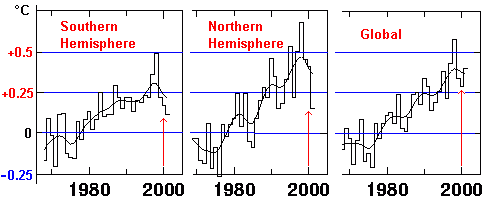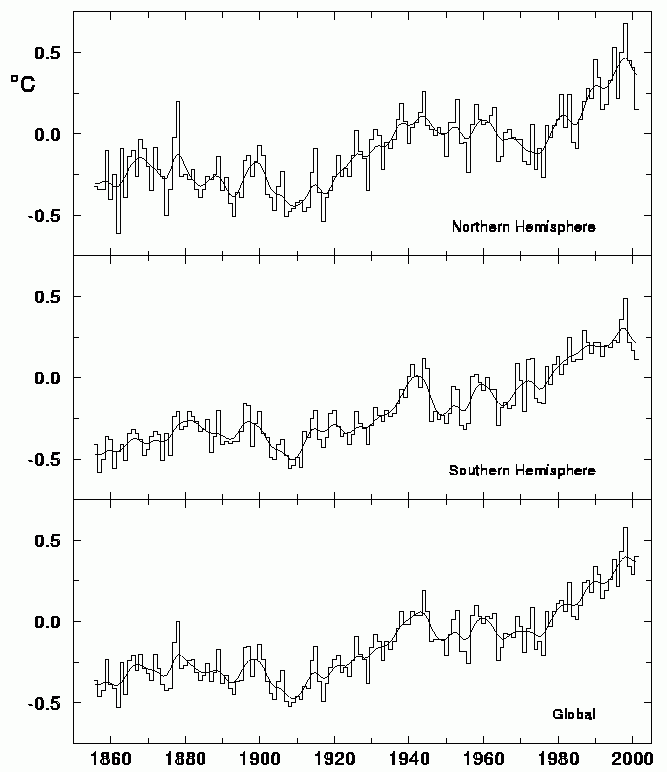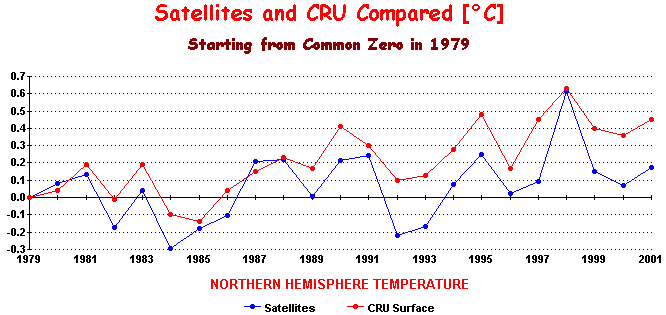|
Quality
Control, CRU Style
by John L. Daly

In the Beginning...
On Friday 10th August 2001, this website revealed a very visible and obvious error in the hemispheric and global temperatures being issued by the
Climate Research Unit (CRU)
of the University of East Anglia, Norwich, England <see the original `stop press' story here>. They
presented graphs which contained a contradiction as
illustrated in Fig.1.

Fig.1 - Hemispheric & global trends compared. (Colour indicators added)
Their hemispheric temperatures were showing a cooling during 2001, while their global temperature
was showing a warming, something which is of course physically impossible. They were clearly incompatible
- and visibly so - as shown in the original CRU graph (Fig.2 below) which was obtained as a postscript file (hemglob.ps) from the data section of their website on Thursday
last (9th August). Also downloaded were
the numerical data files from which the graphs were generated.

Fig.2 - CRU's triple graph showing the contradiction between hemispheres and globe
Within hours of releasing the
story on this website, attempts to gain access to the CRU website were met with `server down or not responding' notices, lasting for about 10 hours.
During this `down' period, other British sites were being accessed without difficulty. When
the CRU site became accessible again, nothing had changed - the same
contradictory graphs were on display and the same data files. In addition,
it was found that the CRU online magazine
Climate Monitor was also showing contradictory graphs.
On Monday morning British
time (13th August), CRU acted to correct some of the data, the first indication of which was
to replace the triple graph with a new version, one which showed the hemispheres now to be warming in line with the global graph which remained unchanged.
See Fig.3 below. No explanation was offered as to why or how the
change had been made.

Fig.3 - The new version of the triple graph which
appeared Monday morning.
However, the contradictory graphs on the
Climate Monitor section of the CRU site remained unchanged throughout Monday and Tuesday.
Later ...
Then, on Wednesday morning (15th August), Australian time, the following CC email arrived from Phil Jones, the head of CRU and the person responsible for the hemispheric and global temperature data.
|
Subject: Problems on some pages of the CRU web site
Date: Tue, 14 Aug 2001 15:42:25 +0100
From: Phil Jones <p.jones@uea.ac.uk>
To: daly@john-daly.com, kateanddavid@hotmail.com, editor@opinionet.com
CC: gareth.s.jones@metoffice.com
Dear All,
A number of you have informed us of some inconsistences with our web site. We have
been automating the way many of the pages are being updated. There
appears to have been some teething problems in the last few weeks. This relates mainly to the
Climate Monitor pages. Data on the ftp site is correct but some of the time series on the
Climate Monitor site and associated graphics have problems during 2001. This seems to
relate to a crash we had a few months ago whereby old files are now being accessed, but the
current dates assumed.
So the NH and SH series numbers are far too low for 2001, because they
are only seeing the Jan and Feb data. The correct values are in the files
tavenh/tavesh/tavegl.dat on the ftp site and on the temperature data page.
Average NH temp for Jan-Jun 2001 is 0.50, for the SH 0.32 and for the globe 0.41. The global value on the plots is correct
as it using a different source than those for NH and SH.
The problem will be sorted once our web manager has some time to sort
it. I apologise for the problem. There is no hint of us manipulating the data, just one
of the code displaying it not working properly.
Best Regards
Phil Jones
PS It would be nice in future to be told this directly, as two of you have done, rather than
be told we are manipulating the data.
Prof. Phil Jones
Climatic Research Unit Telephone +44 (0) 1603 592090
School of Environmental Sciences Fax +44 (0) 1603 507784
University of East Anglia
Norwich Email p.jones@uea.ac.uk
NR4 7TJ
UK
---------------------------------------------------------------------------- |
Taking the `data manipulation' remark
first, nothing in the story presented on this site could be construed as an accusation of deliberate data manipulation.
It is true that CRU's conclusions are not acceptable to most sceptics for reasons well explained and documented elsewhere, but this is a scepticism
of CRU's procedures and methods, not of their ethics. To question someone's judgment and/or competence is not the same as questioning their honesty, even though Jones
might appear to equate the two.
The central point of criticism of the contradictory graphs was not that someone made an error - that can happen anywhere to anyone, part of human nature. Rather, it was the
failure of anyone among CRU's 40-strong staff to even see such an obvious
and visible error on what is their primary public product - hemispheric and global temperature.
`Quality Control' is not merely about elimination of errors, desirable though that goal may be, but rather the active review of everything produced at each stage of processing to detect such errors before they are passed into the public domain.
It is this that CRU failed to do, raising serious doubts as to the effectiveness of their quality control system generally.
The Jones email nevertheless attempted to put as positive a spin as possible on what was really an indefensible failure on their part.
The Explanations ...
"There appears to have been some teething problems in the last few weeks" the email says disingenuously, adding
"This relates mainly to the Climate Monitor
pages".
This is not consistent with what the CRU website was actually showing. The error was clearly present in the data section managed, so the
CRU site says, by Phil Jones himself.
Fig.2 was downloaded directly from Jones' data section, not from Climate
Monitor. It appears that the problem did not relate to Climate Monitor at all, which appeared to be merely repeating a mistake originating from Jones' data section.
"Data on the ftp site is correct but some of the time series on the
Climate Monitor site and associated graphics have problems during
2001", said the email.
When Jones sent the email on Wednesday 15th August, it was by
then true that the data on the ftp site was correct, but it was not correct at the time the story was first released
on this website on Friday 10th August. Fig.4 shows an extract from the part of the data taken from the ftp site during last weekend, the part that shows the data for 2001.
It is clear that the faulty figure was then present in the 2001 annual figures for the hemispheres.
Climate Monitor was merely reflecting that prior error, not causing it.

Fig.4 - Extract of data downloaded on Saturday 11th August.
"So the NH and SH series numbers are far too low for 2001, because they are only seeing the Jan and Feb data."
Look at Fig.4 again at the NH and SH data for 2001. It shows six months, not two, and the
half-year average in the right-hand column is exactly the number you would get if you added January through June and divided by
12 instead of 6. If those numbers were to be divided by 6, the average would then match up to the new revised numbers published on the CRU site. The global data also showed all six months, but if those numbers are added and then divided by 6, the final average is correct.
In the email above, Jones gave the revised averages as 0.5 for the
NH, 0.32 for the SH, and 0.41 for the global. The
global figure is the same, but the revised NH and SH averages are exactly
double the earlier figures, indicating that indeed the January-June total
had been incorrectly divided by 12 instead of by 6.
In other words, the error was quite simple. Someone or something put an incorrect formula into the hemispheric final average spreadsheet cells for 2001, putting a
`divide-by-12' function into it (as would be appropriate for a full year's data) instead of a
`divide-by-6' function which would be necessary when only 6 months of data are available.
Once the data for the hemispheres was averaged incorrectly, which no-one seemed to notice, the resulting graphs generated from that data was passed to the CRU data section on their
website.
What happened at Climate Monitor was even more intriguing.
Their graphs showed the hemispheres to be even cooler than the faulty
graphs and data from the CRU data section. There, the hemispheric files n17.dat and s17.dat did not show
the same error as the files from the CRU data section but rather had quite
separate errors, giving only 0.03 for the NH and 0.02 for
the SH, much lower than even the faulty `divide-by-12' figures. The
puzzle is easily solved if one divides only the January figures in both
hemispheres by 12.
In other words, CRU made two errors, not one, both based
on incorrect averaging, the very core of their institution's work - making
zonal, hemispheric and global averages of historic temperature.
The faulty graphs were then visible to everyone, both within CRU and
without, for about two weeks or more. Yet no-one in this well-staffed public institution spotted the
blunders until it was revealed on this website.
"The correct values are in the files tavenh/tavensh/tavegl.dat on the ftp site and on the temperature data
page".
Too late - the horse has already bolted. Notice Jones uses `are' instead of `were'. By the time
his email was issued, the offending files had indeed been changed. Those
files are now listed on the data section of the CRU website as follows -
tavegl.dat
13-Aug-2001 14:42 27k
tavenh.dat 13-Aug-2001
14:42 27k
tavesh.dat 13-Aug-2001
14:42 27k
The fact that all three files have identical time stamps indicates that they were copied from
another location at exactly the same time.
Here are those same filenames as downloaded last Saturday
(11th August) -
tavenh.dat tavesh.dat.
These are the hemispheric files and examination of both will show that the hemispheric averages for 2001
(as shown in Fig.4) was obtained by a simple
`divide-by-12' mistake, while the global average was done correctly with a
`divide-by-6'.
Phil Jones who is both in charge of CRU overall, and of the hemispheric/global data sets, says in his own bio page,
"I am principally known for the time series of hemispheric and global surface temperatures, which I update on a monthly basis."
In his email, he blamed a computer crash, problems with computer automation,
and Climate Monitor.
From the above account, we can see that the data on the ftp site was faulty last weekend and earlier, the part for which Jones is responsible, and that its current corrected status has been due to changes made to the data and the charts on Monday
13th August. The separate faults on the Climate Monitor
remained uncorrected for another two days.
"There is no hint of us manipulating the data,..."
Who said there was? That was something Jones himself inserted into the issue, a
red herring to explain away a silly and mundane mistake, but one which revealed an
appalling lack of quality control in the very institution which has helped convince governments that the world
was undergoing rapid warming. Data from satellites and well-maintained rural weather stations show such a claim to be
untrue.
"The problem will be sorted once our web manager has some time to sort it." - The
second error sat on the
Climate Monitor part of the CRU site until Wednesday 15th August,
5 days after the error was first revealed on this website. Is their quality control such
that a glaring mistake can just sit there on a publicly funded website while their webmaster `finds time' to fix it?
Does this mean that CRU's quality control culture is so lacking that not only does a visible mistake escape the notice of the 40-strong
staff for over two weeks, but that correcting it takes such a low priority?
Meanwhile
...
We have been repeatedly told
by global warming advocates that the `surface record' compiled by CRU
should be believed in preference to the satellite record because of
rigorous and scientific quality control exercised by CRU. We now see
that this assumption is quite unjustified as the two errors in data
handling not only involved the final product of thousands of individual
calculations, but were so visible as to make one wonder how such a large
staff could not see it.
Clearly, quality control at
CRU is seriously lacking. If such obvious errors can go
uncorrected for two weeks or more, what of the errors that might occur
earlier in the data processing chain?
Even though we now have the
`correct' hemispheric averages for 2001, they are correct only to the
extent that the monthly figures are correct. If the monthly figures
and the zonal and station data which underpin them are subject to the same
kind of quality control, the monthly averages themselves might be quite
meaningless.
This is suggested by the
satellite record. Here is a chart (Fig.5) of
northern hemisphere temperature according to CRU (red) and according to
the satellites (blue).

Fig.5 - Satellite and CRU
surface record compared for the Northern Hemisphere
The CRU graph is trending
upward and now leads the satellite record by nearly 0.3°C even though
both are referenced to a common starting point in 1979 when satellite
monitoring began. In assessing the worth of the CRU view of NH
temperatures in 2001, it should be remembered that only January through
June is being measured and that vast areas of the NH experienced record
low temperatures during the recent northern winter.
The satellite recording system
has been subject to a number of searching and rigorous reviews by
independent scientists, the result of which was the finding of only minor
technical errors caused by satellite changeovers and orbital drift, none
of which altered the record significantly.
Perhaps it is time that the
surface record was given a similar rigorous scrutiny by outside and
independent scientists, especially given the quality control problem that
clearly exists at CRU.
John L. Daly
Wednesday 15th August, 1400 GMT
Thanks to Miceal O'Ronain
and Jerry Brennan for their valuable assistance

Return to `Still Waiting For Greenhouse' main page
|




